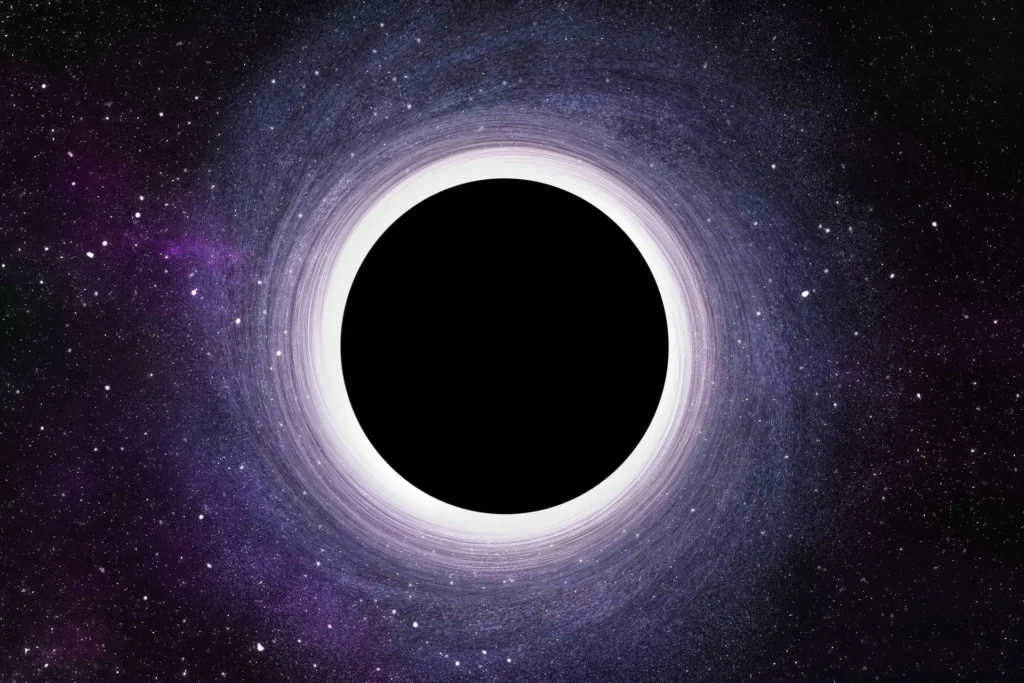
A black hole is a region in spacetime where gravity is so strong that nothing, not even light, can escape it.1 This occurs when a large amount of matter is compressed into a very small space.
Formation of Blackhole: Here’s a breakdown of key aspects:
- Stellar Black Holes: Most commonly, black holes form from the remnants of massive stars (at least 8-10 times the mass of our Sun) that have reached the end of their lives.3 When these stars run out of nuclear fuel, their cores collapse under their own gravity during a supernova explosion.4 If the remaining core is massive enough (more than about three times the mass of the Sun), it continues to collapse into a black hole.
- Supermassive Black Holes: These behemoths reside at the centers of most large galaxies, including our own Milky Way.5 They have masses ranging from millions to billions of times the mass of the Sun. Their formation is still an active area of research, but they may form from the direct collapse of large gas clouds or the merging of many smaller black holes.6
- Intermediate-Mass Black Holes: With masses between stellar and supermassive black holes (hundreds to thousands of solar masses), these are less common and their formation is not fully understood. They might form in dense star clusters through collisions.
- Primordial Black Holes: These are hypothetical black holes that could have formed in the very early universe shortly after the Big Bang.78 They could have a wide range of masses, from smaller than an atom to much larger.
Key Features:
- Observing the Motion of Stars: By tracking the orbits of stars, astronomers can sometimes identify a star orbiting a very massive, unseen object. The speed and radius of the orbit can help determine the mass of the invisible object.13 If the mass is too large to be a neutron star, it’s likely a black hole.
- Accretion Disks: When a black hole pulls in gas and dust from a nearby star or cloud, this material can form a swirling disk around the black hole called an accretion disk.14 Friction within the disk heats the gas to extremely high temperatures, causing it to emit X-rays and other radiation that can be detected by telescopes.15
- Gravitational Waves: The mergers of black holes (and neutron stars) produce ripples in spacetime called gravitational waves.16 These waves can be detected by specialized instruments like LIGO and Virgo, providing direct evidence of black holes and allowing scientists to study their properties.17
- Imaging the Event Horizon: The Event Horizon Telescope (EHT) collaboration has achieved the groundbreaking feat of directly imaging the shadow of the supermassive black hole at the center of the M87 galaxy and, more recently, Sagittarius A* at the center of our Milky Way.18 These images show the region around the event horizon, where light is bent and trapped by the black hole’s intense gravity.
- Event Horizon: This is the “point of no return” around a black hole.9 It’s a boundary in spacetime beyond which nothing, not even light, can escape the black hole’s gravitational pull.10
- Singularity: At the very center of a black hole lies the singularity, a point where all the black hole’s mass is concentrated into an infinitely small volume and where the density and gravity become infinite according to classical general relativity. What truly happens at the singularity is unknown and likely requires a theory of quantum gravity.
- Gravity: Black holes have incredibly strong gravitational fields.11 The closer you get to a black hole, the stronger the pull.
- No Light Emission: Black holes themselves do not emit or reflect light, which makes them invisible to direct observation.12 However, their presence can be inferred by their gravitational effects on surrounding matter.
How We Detect Black Holes:
Since we can’t see black holes directly, scientists rely on indirect methods:
Black holes are fascinating and extreme objects that continue to challenge our understanding of gravity and the universe. They play a crucial role in the evolution of galaxies and are a subject of intense ongoing research.
One response to “Blackhole : Strength of gravity”
-
Good knowledge
Leave a Reply to Jitendra mishra Cancel Reply